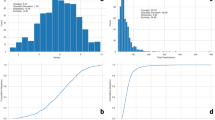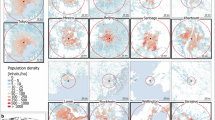Abstract
Ethnic minorities often face environmental inequalities, as they are more likely to be exposed to hazardous and polluting facilities. Yet the role of urban planning on shaping these inequalities, particularly in Europe, remains understudied. The siting of Traveller sites offers a clear example of how repeated urban planning decisions can produce systemic discrimination, as local representatives determine where Travellers are allowed to stay, thereby directly influencing their exposure to environmental disamenities. Here by linking Traveller sites in France with socioeconomic and environmental data, we provide statistical evidence that Traveller sites are more likely to be implemented in cities with more disamenities and that sites are more exposed than any other residential areas within these cities (even other disadvantaged households). On the basis of our findings, we discuss two potential mechanisms that may underpin this discrimination: cost minimization and discriminatory preferences of local representatives and residents. The Travellers case illustrates the need for more thorough examinations of how urban planning decisions contribute to socio-spatial inequalities, particularly in the European context.
This is a preview of subscription content, access via your institution
Access options
Subscribe to this journal
Receive 12 digital issues and online access to articles
$119.00 per year
only $9.92 per issue
Buy this article
- Purchase on SpringerLink
- Instant access to full article PDF
Prices may be subject to local taxes which are calculated during checkout





Similar content being viewed by others
Data availability
The initial dataset on Traveller sites, exposure to environmental amenities and disamenities and accessibility to public services is available at https://doi.org/10.57745/G1LWND, Recherche Data Gouv, V1. Additional data are available via Zenodo at https://doi.org/10.5281/zenodo.15518253 (ref. 39).
Code availability
Additional code are available via Zenodo at https://doi.org/10.5281/zenodo.15518253 (ref. 39).
References
Holifield, R., Chakraborty, J. & Walker, G. The Routledge Handbook of Environmental Justice (Routledge, Taylor & Francis Group, 2018).
Coolsaet, B. Environmental Justice: Key Issues (Routledge, 2020).
Kato-Huerta, J. & Geneletti, D. Environmental justice implications of nature-based solutions in urban areas: a systematic review of approaches, indicators, and outcomes. Environ. Sci. Policy 138, 122–133 (2022).
Drupp, M. A., Kornek, U., Meya, J. N. & Sager, L. The economics of inequality and the environment. CESifo Working Paper No. 11036. Preprint at SSRN https://doi.org/10.2139/ssrn.4788235 (2024).
Gerrish, E. & Watkins, S. L. The relationship between urban forests and income: a meta-analysis. Landscape Urban Plann. 170, 293–308 (2018).
Shao, S., Liwen, L. & Zhihua, T. Does the environmental inequality matter? A literature review. Environ. Geochem. Health 44, 3133–3156 (2022).
Boone, C. G., Buckley, G. L., Grove, J. M. & Sister, C. Parks and people: an environmental justice inquiry in baltimore, maryland. Ann. Assoc. Am. Geogr. 99, 767–787 (2009).
Nesbitt, L., Meitner, M. J., Girling, C., Sheppard, S. R. J. & Lu, Y. Who has access to urban vegetation? A spatial analysis of distributional green equity in 10 US cities. Landscape Urban Plann. 181, 51–79 (2019).
Pastor, M., Sadd, J. & Hipp, J. Which came first? Toxic facilities, minority move‐in, and environmental justice. J. Urban Aff. 23, 1–21 (2004).
Mohai, P., Pellow, D. & Roberts, J. T. Environmental justice. Annu. Rev. Environ. Resour. 34, 405–430 (2009).
Banzhaf, S., Ma, L. & Timmins, C. Environmental justice: the economics of race, place, and pollution. J. Econ. Perspect. 33, 185–208 (2019).
Cain, L., Hernandez-Cortes, D., Timmins, C. & Weber, P. Recent findings and methodologies in economics research inenvironmental justice. Rev. Environ. Econ. Policy 18, 116–142 (2024).
Mork, D., Delaney, S. & Dominici, F. Policy-induced air pollution health disparities: statistical and data science considerations. Science 385, 391–396 (2024).
Bullard, R. D. Confronting Environmental Racism: Voices from the Grassroots (South End Press, 1993).
Banzhaf, S., Ma, L. & Timmins, C. Environmental justice: establishing causal relationships. Annu. Rev. Resour. Econ. 11, 377–398 (2019).
Henderson, S. & Wells, R. Environmental racism and the contamination of black lives: a literature review. J. Afr. Am. Stud. 25, 134–151 (2021).
Swope, C. B., Hernández, D. & Cushing, L. J. The relationship of historical redlining with present-day neighborhood environmental and health outcomes: a scoping review and conceptual model. J. Urban Health 99, 959–983 (2022).
Lane, H. M., Morello-Frosch, R., Marshall, J. D. & Apte, J. S. Historical redlining is associated with present-day air pollution disparities in US cities. Environ. Sci. Technol. Lett. 9, 345–350 (2022).
Chyn, E., Collinson, R. & Sandler, D. H. The long-run effects of america’s largest residential racial desegregation program:Gautreaux. Q. J. Econ. 140, 2213–2267 (2025).
FRA Roma and Travellers in Six Countries (European Union Agency for Fundamental Rights, 2020).
Morgan, J. & Belenky, N. Exploring health inequalities in gypsy and traveller communities in the uk. Nurs. Stand. 39, 69–73 (2024).
Parry, G. et al. Health status of Gypsies and Travellers in England. J. Epidemiol. Commun. Health 61, 198–204 (2007).
Lauritzen, S. M. & Nodeland, T. S. ‘What is the problem represented to be?’ Two decades of research on Roma and education in Europe. Educ. Res. Rev. 24, 148–169 (2018).
Parthenis, C. & Fragoulis, G. ‘Otherness’ as threat: social and educational exclusion of Roma people in Greece. Int. J. Multicult. Educ. 18, 39–57 (2016).
Lane, P., Spencer, S. & Jones, A. Gypsy, Traveller and Roma: Experts by Experience (Anglia Ruskin University, 2014)
James, Z. in The Routledge International Handbook on Hate Crime (eds Hall, N., Corb, A., Giannasi, P. & Grieve, J.) 237–248 (Routledge, 2014).
30e Rapport annuel sur la lutte contre le racisme, l’antisémitisme et la xénophobie (Commission nationale consultative des droits de l’homme, 2021).
Bancroft, A. Roma and Gypsy-Travellers in Europe: Modernity, Race, Space and Exclusion (Ashgate Publishing Limited, 2005).
Brender, J. D., Maantay, J. A. & Chakraborty, J. Residential proximity to environmental hazards and adverse health outcomes. Am. J. Public Health 101, S37–S52 (2011).
L’accueil et l’accompagnement des gens du voyage des gens du voyage (Cour des Comptes, 2012).
Acker, W. Où sont les ‘gens du voyage’? Inventaire critique des aires d’accueil (Editions du Commun, 2021).
Acker, W. in Écologies: Le vivant et le social (eds Boursier, P. & Guimont, C.) 341–348 (La Découverte, 2023).
Dear, M. Understanding and overcoming the nimby syndrome. J. Am. Plann. Assoc. 58, 288–300 (1992).
Takahashi, L. M. The socio-spatial stigmatization of homelessness and HIV/AIDS: toward an explanation of the nimby syndrome. Social Sci. Med. 45, 903–914 (1997).
Borell, K. & Westermark, Å Siting of human services facilities and the not in my back yard phenomenon: a critical research review. Commun. Dev. J. 53, 246–262 (2018).
Bloch, A. & Quarmby, K. Environmental racism, segregation and discrimination: Gypsy and Traveller sites in Great Britain. Crit. Social Policy (2024).
Foisneau, L. Les aires d’accueil des gens du voyage: une source majeure d’inégalités environnementales. Etudes Tsiganes 67, 28–51 (2019).
Tardieu, L., Leblois, A., Sensier, A. & Delacote, P. Aires d’accueil des gens du voyage, exposition aux aménités et désaménités environnementales et accès aux services publics. Tetis https://doi.org/10.57745/G1LWND (2024).
Leblois, A., Tardieu, L., Mondolfo, N. & Delacote, P. Environmental discrimination through urban planning: the case of French Traveller sites. Zenodo https://doi.org/10.5281/zenodo.15518253 (2025).
Pulido, L. A critical review of the methodology of environmental racism research. Antipode 28, 142–159 (1996).
DHUP Mise en oeuvre des schémas départementaux d’accueil des gens du voyage (Direction de l’habitat, de l’urbanisme et des paysages, Ministère de la cohésion des territoires et des relations avec les collectivités territoriales, 2021).
Hite, D., Chern, W., Hitzhusen, F. & Randall, A. Property-value impacts of an environmental disamenity: the case of landfills. J. Real Estate Finance Econ. 22, 185–202 (2001).
De Vor, F. & De Groot, H. L. F. The impact of industrial sites on residential property values: a hedonic pricing analysis from the netherlands. Reg. Stud. 45, 609–623 (2011).
Currie, J., Davis, L., Greenstone, M. & Walker, R. Environmental health risks and housing values: evidence from 1,600 toxic plant openings and closings. Am. Econ. Rev. 105, 678–709 (2015).
Esaiasson, P. Nimbyism–a re-examination of the phenomenon. Social Sci. Res. 48, 185–195 (2014).
Wexler, M. N. A sociological framing of the NIMBY (not-in-my-backyard) syndrome. Int. Rev. Modern Sociol. 26, 91–110 (1996).
Foster, D. & Warren, J. The NIMBY problem. J. Theor. Polit. 34, 145–172 (2022).
Pellow, D. N. Environmental inequality formation: toward a theory of environmental injustice. Am. Behav. Sci. 43, 581–601 (2000).
Blanpain, N. & Lincot, L. Avoir trois enfants ou plus à la maison. INSEE première (INSEE, division Enquêtes et études démographiques, 2015).
Fédération Nationale des Associations Solidaires d’Action avec les Tsiganes et les Gens du Voyage. Une relance des schémas départementaux en trompe-l’oeil? Fnasat-info 7, 7–8 (2022).
Acknowledgements
We are grateful to A. Sensier for his work on the geodata collection. We are also grateful to many academic and non-academic colleagues, in particular W. Acker and the members of the Paris-Saclay Applied Economics laboratory, who provided fruitful feedback on early versions of this work. The Bureau d’Economie Théorique et Appliquée contributes to the Labex ARBRE ANR-11- LABX-0002-01. This research is part of the Agriculture and Forestry research program by the Climate Economics Chair.
Author information
Authors and Affiliations
Contributions
N.M. drafted most of the initial outline and core initial content of the paper, with A.L., P.D. and L.T. enriching the outline and text with further illustrations, references and precisions. They also thoroughly edited the text. L.T. developed the initial spatial dataset with input from A.L. and P.D. N.M. carried out the statistical analysis with input and advice from the other authors. All authors have revised the manuscript.
Corresponding author
Ethics declarations
Competing interests
The authors declare no competing interests.
Peer review
Peer review information
Nature Cities thanks Giovanni Picker and the other, anonymous, reviewer(s) for their contribution to the peer review of this work.
Additional information
Publisher’s note Springer Nature remains neutral with regard to jurisdictional claims in published maps and institutional affiliations.
Supplementary information
Supplementary Information
Additional definitions, Summary statistics, Regression results, Sensitivity checks and References.
Rights and permissions
Springer Nature or its licensor (e.g. a society or other partner) holds exclusive rights to this article under a publishing agreement with the author(s) or other rightsholder(s); author self-archiving of the accepted manuscript version of this article is solely governed by the terms of such publishing agreement and applicable law.
About this article
Cite this article
Mondolfo, N., Leblois, A., Delacote, P. et al. Urban planning decisions expose Traveller sites to disproportionate environmental burdens. Nat Cities 2, 865–874 (2025). https://doi.org/10.1038/s44284-025-00307-w
Received:
Accepted:
Published:
Issue date:
DOI: https://doi.org/10.1038/s44284-025-00307-w



